Notes
In the Lifelines section below, I’ve listed the women photographers from Lowell who I mention in this podcast episode.
To date, I have only managed to track down a few examples of their work:
Miss C. Smith (c. 1877-1905) – see examples and more information posted in the notes for Episode notes for 15 – Miss C Smith.
Kimball’s Photographic Studio, 112 Merrimack Street, Lowell, MA
Photographer: M. Frank Kimball, 1877-1882
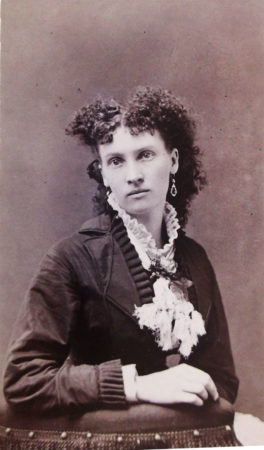

In 1882, Miss M. Frank Kimball marries another photographer, Mr. W.H. Southard, and they continue to run the Kimball’s Photographic Studio together.
Kimball’s Photographic Studio, 112 Merrimack Street, Lowell,, MA
Photographers: W.H. & M.F. Southard, 1882-1889

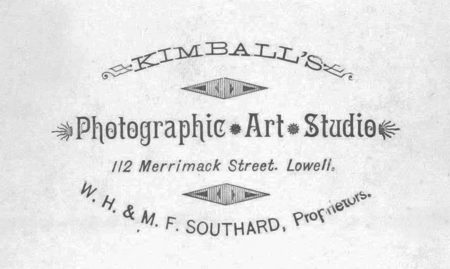
Photographers: Serge & Gustav Duclos, 1899-1904
Lifelines
Recommended Links
- University of Massachusetts Center for Lowell History – View
- Family Search website has U.S. Federal Census and more; free account required – Visit
- Ancestry.com (census records, city directories, and more; paid account required – Visit
- Newspapers.com has a selection of digitized newspapers from the United States; paid account required – Visit
- Newspaperarchives.com has a selection of digitized newspapers from the United States; paid account required – Visit
- Geneologybank.com has a selection of digitized newspapers from the United States; paid account required – Visit
- 1899 Poems by Cora C. Bass on Project Gutenberg – View
- 1901 Songs for all Seasons (poetry) by Cora C. Bass on Project Gutenberg – View
- Massachusetts Photographers, A Directory of 1839-1900
by Chris Steele and Ronald Polito – Buy
Transcript
You’re listening to Photographs, Pistols, and Parasols.
Support for this project is provided by listeners like you. Check out my website at p3photographers “dot” net for ideas on how you, too, can become a supporter of the project.
Welcome to Photographs, Pistols & Parasols, the podcast where we celebrate early women artisan photographers.
I’m your host, Lee McIntyre.
In today’s episode I’m going to introduce you to the range of narratives that we find when we look at the early women photographers in Lowell, Massachusetts.
For more information about any of the women discussed in today’s episode, visit my website at p3photographers.net. That’s letter “p”, number “3”, photographers “dot” net.
*****
Last week I focused on Miss Costilla Smith, the woman who worked as a photographer for over 30 years in Lowell, Massachusetts.
Before I move on from Lowell, though, I want to bring you some information that I realized as I was preparing that episode.
My project in general looks at the multi-threaded narratives of women artisan photographers — in other words, the different facets of the lives of the early women photographers that I’ve been looking at all over the country, and all over the world.
As it turns out, though, Lowell, Massachusetts, provides us with a microcosm of many of those threads that I’m finding all over the place.
And so I just want to take a moment today to celebrate some of these women that I’ve uncovered.
Now, I’m not going to talk about them in detail, but I think it is important to point out that there really were a lot of early women photographers.
Now it’s possible that by only doing one or two photographers each episode I may be accidentally implying that there aren’t that many women photographers.
But that really isn’t the case, and so today I want to give you a sense of just the broad range of the different stories and the different types of women who were photographers, specifically photographers here in Lowell, Massachusetts representing the kinds of photographers we find all over.
For example, let’s start with someone I actually mentioned last week in passing, Miss M. Frank Kimball.
Now Miss M. Frank Kimball had a couple of brothers who ran a photography studio in the early days in Lowell, Massachusetts, but when they leave in 1877 their sister, Miss M. Frank Kimball, who had been working for them for several years before they leave, well, Miss M. Frank Kimball takes over running the studio on her own.
Now she factored into our story last week because she’s part of that crazy mix up in the 1880 census where she doesn’t appear, nor does Miss C. Smith.
But she was the proprietress of the Kimball’s Photograph Studio, starting in 1877. She ran it on her own, and then in 1882 she actually is still the proprietress, but at that point she’s actually running out with her husband, W. H. Southard.
Women working with their husbands in the studios is another type of narrative that we find running through the stories I’ve been uncovering.
In addition to women like Mrs Southard, who actually operates a studio with her husband, we find other women like Mrs. Fontaine. Now, it was Mrs Joseph Telesphore Fontaine, who later was Mrs Emma Fontaine — she marries Joseph T. Fontaine in 1897. He has been an established photographer, and [was] a competitor of Miss C. Smith and Miss Kimball in the 1880s.
In 1897 he continues to run the studio after marrying Emma, but in 1903 he dies suddenly, and she carries on for another decade.
Now, the studio is then renamed as Mrs Joseph T. Fontaine or Mrs T. Fontaine or then, for the last five years she’s running a studio it’s actually just Mrs. Emma B. Fontaine.
Now she had a pretty long career: over ten years as I count as pretty long. Miss Kimball, rather Mrs. Southard, also had a pretty long career.
Of course, Miss C. Smith had a very long career, over thirty years.
But we also find examples of women who had a bit shorter stints.
So, maybe they were just doing it for a year on their way between other careers: some became or were teachers before and after they were photographers, that kind of thing.
Now we find a few of these women who are also competitors of Miss C. Smith back in the 1880s.
Women like Mrs Addie J. Warren, who is connected somehow to Oliver Warren, who was a photographer with a studio under his own name for a many years.
Addie and Oliver were married at some point, but whether or not when she’s running her own studio she still married to Oliver or not, that’s an issue that I still have to research.
We also have a woman like Miss Clara Bean, who is curiously running a studio called “S. Herbert Lodge & Co”, so I expected to find an S. Herbert Lodge living in Lowell at some point, but I didn’t ever find anyone by that name.
And then we have Mrs Eugene Davis, who is a partner in the Dexter and Davis studio, running it with a man named George Dexter.
Now when we find women running a studio with different partners, we find different kinds of combinations.
We have the husband-wife, like the Southards; or we have two brothers like the Kimball brothers; before Miss Kimball takes over; or we have the sister-brother combinations where the sisters and brothers are working together; or we have partners who are unrelated like Mrs Davis, who I don’t know that she’s are actually related to that Mr. Dexter of the Dexter and Davis studio.
But we definitely have a woman named Serge Duclos, who was a female photographer in Lowell, Massachusetts, who actually had many different partners, some family and some not.
In 1899, a family named Duclos came to Lowell. Initially, it’s Gustav and Serge Duclos — they are brother and sister, and they’re running a studio that’s under Gustav’s name.
But when he leaves town, the studios switches to Serge’s name, and she runs it then with a variety of other people — both more family and some not — for over 20 years.
At the end of her stint in Lowell in the 1920, Serge and her sister Celestine are running the studio, which at that point they have renamed to be the Duclos Portrait Studio.
Funnily enough, the listing for Serge and Celestine in the transcriptions of the Lowell city directories often gets interpreted as being a man and wife combination, because Serge is typically a man’s name.
But then again, we’ve seen this before with “M. Frank Kimball”.
If it weren’t for the fact that she always lists herself as “Miss M. Frank Kimball” in the directory we might have thought that was a man.
Serge only occasionally lists herself as “Miss Serge Duclos”; more often than not it’s without any kind of title.
The Duclos were actually a very successful family of photographers, not just in Lowell but all over New England.
There’s a 1909 article that was written in the New Hampshire papers about them.
That’s where a lot of them were based, and it talks about how Serge’s parents, all of her brothers and her sister, as well as the grandchildren, are actually all in the photography business. So lots of other women there, but also just lots of successful studios being run all over New England.
In that article Serge is referred to as “Sadie”, which was apparently the nickname her family gave her.
Why they named her “Serge” and then called her “Sadie” I’m not sure, but that’s an area that I’ve going to explore, to see if I can find out more about that family at some point.
But as I mentioned, Serge didn’t only partner with family members; she actually had a non-family member partner, Miss Rose D. Ouellette.
The Duclos & Ouellette Studio is in business for a decade in Lowell Massachusetts, and while they’re running the studio together, they actually are also living together.
But eventually the Duclos & Ouellette Studio breaks up, and Serge and Rose subsequently operate studios under their own names in Lowell, MA, though.
But their live apart, and in 1920 Serge is living just with her sister, Celestine, and Rose is boarding with another family that includes Mrs Exilia Lariviere, who is actually another woman photographer.
But Mrs Lariviere is another type of woman photographer, because she is somebody working in the photography business, but not actually running her own studio.
And I’m mostly focused in this project on women who are running their own studios.
But there were a number of women working in the photography studios in Lowell, Massachusetts.
I mean there were a lot of studios in Lowell, Massachusetts.
I would say at any given time, in a town that has a peak population of a 112,000 around WWI, at any given moment there were 15-20 studios, and of those studios, there were at least 2 or 3 being run by women, and probably many more staffed by women as well.
Now, one thing I haven’t mentioned is anything about the socio-economic status of the women photographers there in Lowell.
Many of these women worked to support their family.
I mean, they were doing the work to run a studio to make money, competing with the men running the studios who were trying to make money as well.
Some of the women were seemingly very prosperous. I mean, the Duclos family definitely was a very prosperous, very successful family of photographers.
So Serge seems like she also was very successful there in Lowell.
The Duclos family also looked like — at least Serge’s generation — did it from the get-go, in terms of their careers.
So, her parents were photographers, and all of her siblings were photographers. It didn’t seem like they ever did anything else.
But other women who took this up to make money, well, they didn’t necessarily do it at the start of their careers.
An example of that is a woman named Miss Cora C. Bass.
Cora C. Bass was a photographer in Lowell, Massachusetts in the Photographers listing in the directories from 1914-1928.
But before she’s a photographer, she’s actually a successful author, particularly a poet — or, as they called it in the early 20th century, a “poetess”.
Her work appears in newspapers all over the country, and she’s really locally famous.
The newspapers make a big deal around 1894 when she first starts publishing that initially her work was published under the nom de plume “Harley Vane”.
But soon after that it’s published under her own name, and the Lowell newspaper is very proud of that.
She publishes two collections of her poetry, in 1899 and 1901, which are essentially reprints of poems that appeared in newspapers all across the country.
But in 1914 she becomes a professional photographer, listing herself in the Photographers listing.
Now, that turns out to be right after her father dies; her mother is still living and in order to support her mother, perhaps, she becomes a photographer.
When you look in the newspapers — when she’s written up — you realize that her poems are celebrated in her own day, but nobody really talks about her photography.
She was just a day-in, day-out, work-a-day studio photographer, making a living from photography, but really celebrated for another one of her creative outlets.
Now, it’s not often that I find a woman who was also an author, and it was kind of fun to be reading her poetry, finding all these hits in the digital newspapers, to figure out how many places had reprinted her poems.
And I have an odd way of becoming attached to the women as I’m researching them. Even though, I mean, they’re long gone, and I’ll never actually know them, but sometimes it would be fun to think, oh wow, she would really been an interesting person to talk to, because she had so many different interests, the poetry and the photography.
But then I ran across as scan in a newspaper from 1928, and I open it, and I see the following headline:
Woman Poet Don’s Best Gown Then Takes Life
Wow. Really?! That is so sad. I mean, it’s a shock to realize that she came to such a sad, tragic end.
The Lowell Sun [newspaper], which had really liked her poetry, writes up her death on January 26, 1928, the day that it happened.
And it gives detail about her death, including how she wrote a letter to the deacon of her church with a final poem, which essentially was her suicide note.
The deacon rushed to her house when he got the letter, but it was too late.
Now, the newspaper reprints this suicide note/poem.
But then the next day says, you know, that wasn’t a great example of her work; we really need to celebrate her talents with something better.
And so they reprint an earlier poem called “A Memorial Poem” which was dedicated to the Grand Army of the Republic.
As it turns out, her two collections of poetry are both included on the Project Gutenberg site for free, so I’ll put links to her poetry on the episode notes for this episode.
So, not only do we have the triumphs, but we have the tragedies that we run across with women photographers.
We truly have a microcosm of all those stories, including that kind of tragedy, here in Lowell, Massachusetts.
But of course, Cora Bass’ death is not the end to women photographers in Lowell, Massachusetts.
The next year more women [photographers] come to Lowell, and we have even more stories.
But for today, I just wanted to give you a sense of different kinds of narratives that I’m finding when researching these women, and to give you a sense of the fact that there’s more than just one … more than just two … at any given moment in some of these towns.
And in Lowell, what’s really surprising, but also really gratifying to see, is that we have such a wide mix of all the different kinds of narratives represented here in one place.
Today I’ve only given you a high level look at all of these women; definitely it’s something I want to come back to, to dive into their stories and uncover even more about their lives and their careers.
But in the meantime I really want to thank the University of Massachusetts Center for Lowell History, the same place that I talked about last week as having gone to [in order] to research Miss C. Smith, because I use a lot of materials that I gathered when I was there.
In addition, some of the materials I used today, like the newspaper articles I found in places like newspapers.com, newspaperarchives.com, ancestry.com; those are all sites that require a paid account.
But then they are also the free sites like Project Gutenberg (for Cora Bass’ poetry) and also the familysearch.org website, and a couple of other links that I’ll put up on the episode notes.
Also, I do want to mention that there’s a great directory of Massachusetts photographers from 1839-1900 by Chris Steele and Ron Polito. It is a great resource, because what they did is gather a lot of the directory listings and have it all in one place. You can see who was in Lowell, Massachusetts between 1839-1900, and who was anywhere else in Massachusetts in that time period. It’s very handy, since it has all the information all in one place.
Well, as I’ve said, all of these links, as well as some of the photos that I’ve uncovered that were done by some of these women, I’ll put up on the episode notes as usual at p3photographers.net That’s letter “p” number “3” photographers.net.
Also, remember you can always drop me a line with any questions at podcast “at” p3photographers.net
Or, follow me on Facebook at facebook.com/p3photographers.
Support for this podcast is provided by listeners like you. Go my website at p3phographers.net to get ideas on how you, too, can become a supporter of the project.
Well that’s it for today.
Thanks for stopping by!
Until next time, I’m Lee McIntyre, and this is Photographers, Pistols & Parasols.
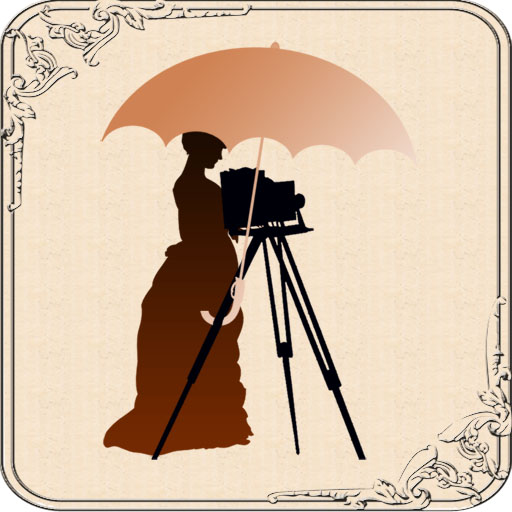
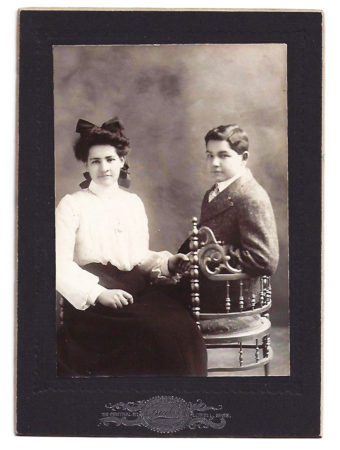
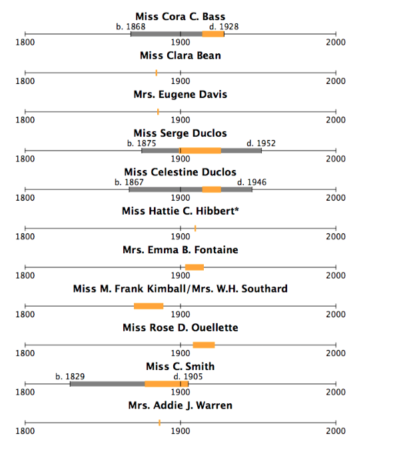
1 thought on “16 – Early Woman Photographers from Lowell”
Comments are closed.